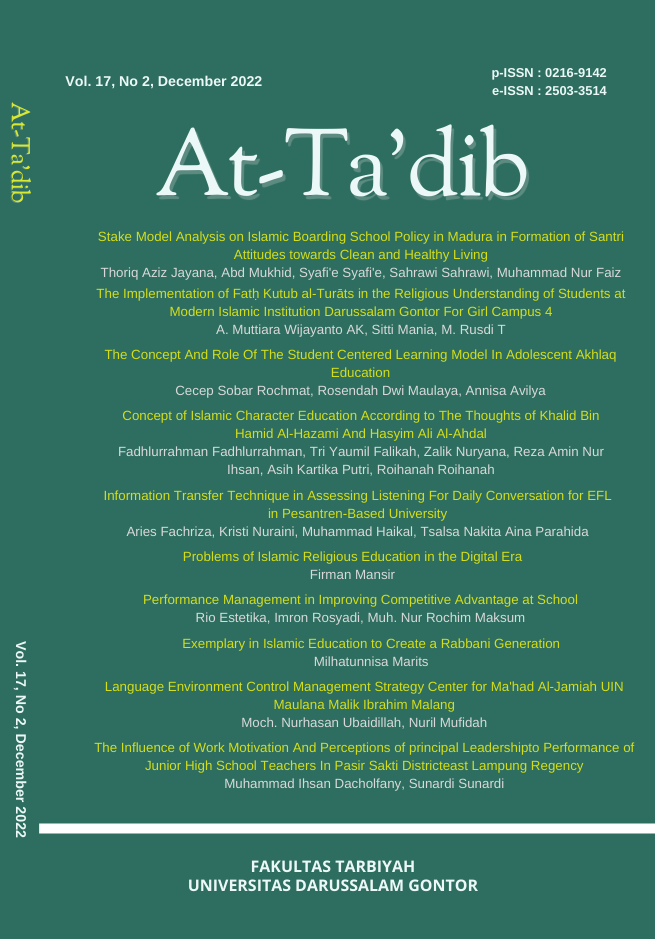Information Transfer Technique in Assessing Listening For Daily Conversation for EFL in Pesantren-Based University
DOI:
https://doi.org/10.21111/at-tadib.v17i2.8795Keywords:
Assessing on Teaching ListeningAbstract
The assessment was becoming part of teaching activities to measure the learning target. It requires several assessment aspects to gain the language learning achievements of the learners. This article intended to examine the strength of the Information Transfer Technique (ITT) in assessing listening for a daily conversation subject for the students in the first year of students of English Department, the University of Darussalam Gontor which is considered as a Pesantren-based university. The research employed a quasi-experimental with control and experiment groups with a post-test design. Each group consisted of 16 colleagues who were regarded as English Foreign Language learners. Their listening subject was assessed by post-test using the information transfer technique in both control and experimental group.The data were analyzed by an independent sample T-Test. The findings revealed that there was a significant inequality between the mean score of pre and post-test. The mean score of the post-test of learners in the experiment group was significantly higher than that in a pre-test. Furthermore, It is proven that the technique of information transfer is assumed eligible to assess the teaching-learning activities in listening for daily conversationReferences
Al-Nafisah, K. I. . Issues and Strategies in Improving Listening Comprehension in a Classroom. International Journal of Linguistics, 11(3), 93. https://doi.org/10.5296/ijl.v11i3.14614. 2019 Biggs, J. Teaching for Quality Learning at University. Maidenhead;.2013 Brown, D. Language Assessment principles and Classroom Practices. Pearson Education.Inc. 2004 Brown, H. D. Language Assessment Principles and Classroom Practices. 2003 Buck, G. Assessing Listening. Cambridge University Press. 2001 Diding Fahrudin. “English Language Teaching in Pesantren Institutions in Indonesia: from Colonial to Global Prespectives. Proceeding of the 4th International Conference on Indonesian Studies: “Unity, Diversity, and Future.2012 Dimitrov, D., & Rumrill, P. Pretest-posttest designs and measurement of change. Speaking of Research, 4(5). 2003 Erwin, T. D. Assessing student learning and development: A guide to the principles, goals, and methods of determining college outcomes. Hoboken, NJ: Jossey-Bass. 1991 Gilakjani, A. P., & Sabouri, N. B. . Learners ’ Listening Comprehension Difficulties in English Language Learning : A Literature Review. 9(6), 123–133. https://doi.org/10.5539/elt.v9n6p123 ( 2016) Graham, S. Listening Comprehension : The students’ Perspectives. An International Journal of Educational Technology and Applied Linguistics, 34, 165–182. 2006 Husain, D. (1994). Information Transfer. Jurnal Pendidikan Dan Keguruan IKIP Makassar, Volume 2 N. 1994 Johnson, P. & Costello, P. Principles for literacy assessment. Reading Research Quarterly, 2(40), 256. 2005 Li, W. & Renandya, W. A. Effective approaches to teaching listening: Chinese EFL teachers’ perspectives. Journal of Asia TEFL, 9(4). 2012 Malgorzata Ciesielska, K. W. B., & Ö. Observation Method. In Research Gate. Researchgate.2018 Muijs, D. Doing Quantitative Research in Education with SPSS. SAGE Publications Ltd. 2004 Naizhoa, G & Robin, W. An Investigation of Factor Influencing English Listening Comprehension and Possible Measure for Improvement. 2009 Nation, P. Using Technique Well: Information Transfer. A Periodical for Classroom Language Teacher, 10(1), 17–23. 1988 Nunan, D. N). Practical English Language Teaching (International Edition)o Title. MC Grew Hill.2001 Philips, Cassandra; Ahrenhoester, G. Class Size and First-Year Writing Exploring the Effects on Pedagogy and Student Perception of Writing Process. Teaching English in the Two Year College, 46(1). https://www.proquest.com/docview/2136865289?pq-origsite=gscholar&fromopenview=true 2018 Radhiyani, F. Developing The Students’ speaking Performance through information Transfer Technique. Jurnal Pemikiran Ilmiah Dan Pendidikan Administrasi Perkantoran, 5(2). 2018 Richard, J.C & Schmidt, R. Longman Dictionary of Language Teaching and Applied Linguistic. Pearson Education Limited. 2002 Derrry, trategies for Assessing Learning Effectiveness. http://www.alnresearch.org/HTML/AssessmentTutorial. 2001 Syam, U. K., & Sangkala, I. Information Transfer Technique in Teaching Writing. Exposure : Jurnal Pendidikan Bahasa Dan Sastra Inggris, 3(1), 97. https://doi.org/10.26618/ejpbi.v3i1.800. 2014 Umam, C. Maintaining Islamic Values in English Language Teaching in Indonesian Pesantrens. Didaktika Religia, 2(1), 227–242. https://doi.org/10.30762/didaktika.v2i1.139.2014 Vandergrift, L., & Goh, C. C. M. Teaching and Learning Second Language Listening. Routledge.2012 Wang, Y. To Give Control to Learners or Not? A Comparative Study of Two Ways of Teaching Listening. English Language Teaching, 3(2), 162–174. https://doi.org/10.5539/elt.v3n2p162.2010 Weeden, P., Winter, J. & Broadfoot, P. Assessment: What’s in it for schools? Routledge Falmer.2002 White, H., & Sabarwal, S. Quasi-Experimental Design and Methods ( Vol 8). United Nations Children’s Fund (UNICEF).2014 Yonantha, F. The Effects of Using Information Transfer Technique Toward Students ’ Listening Comprehension. 1(2), 2020. p. 88-89 Ju-qing, M. Z. Information Transfer Technique in Classroom Interaction. 13(5), 357–362. https://doi.org/10.17265/1539-8080/2015.05.005. 2015
Downloads
Submitted
Accepted
Published
How to Cite
Issue
Section
License
Copyright Notice
Authors who publish with this journal agree to the following terms:
- Authors retain copyright and grant the journal right of first publication with the work simultaneously licensed under a Creative Commons Attribution License that allows others to share the work with an acknowledgment of the work's authorship and initial publication in this journal. Creative Commons Attribution-ShareAlike 4.0 International License.
- Authors are able to enter into separate, additional contractual arrangements for the non-exclusive distribution of the journal's published version of the work (e.g., post it to an institutional repository or publish it in a book), with an acknowledgment of its initial publication in this journal.
- Authors are permitted and encouraged to post their work online (e.g., in institutional repositories or on their website) prior to and during the submission process, as it can lead to productive exchanges, as well as earlier and greater citation of published work.
- The author warrants that the article is original, written by stated author(s), has not been published before, contains no unlawful statements, does not infringe the rights of others, is subject to copyright that is vested exclusively in the author and free of any third party rights, and that any necessary written permissions to quote from other sources have been obtained by the author(s).

AT-TA'DIB: Journal of Pesantren Education Published by Faculty of Tarbiyah, University of Darussalam Gontor, Indonesia is licensed under a Creative Commons Attribution-ShareAlike 4.0 International License.
Based on a work at https://ejournal.unida.gontor.ac.id/index.php/tadib/index








